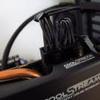FCAT Frame Experience Analysis Tomb Raider
With a new benchmark technology called FCAT on the following three pages we will look into Frame Experience Analysis. Basically with the charts shown we are trying to show you graphics anomalies like stutters and glitches in a plotted chart. Lately there has been a new measurement introduced, latency measurements. Basically it is the opposite of FPS.
- FPS mostly measures performance, the number of frames rendered per passing second.
- Frametime aka Frame Experience recordings mostly measures and exposes anomalies - here we look at how long it takes to render one frame. Measure that chronologically and you can see anomalies like peaks and dips in a plotted chart, indicating something could be off.
| Frame time in milliseconds |
FPS |
| 8.3 | 120 |
| 15 | 66 |
| 20 | 50 |
| 25 | 40 |
| 30 | 33 |
| 50 | 20 |
| 70 | 14 |
We have a detailed article (read here) on the new FCAT methodology used, and it also explains whay we do not use FRAPS anymore.
Frametime - Basically the time it takes to render one frame can be monitored and tagged with a number, this is latency. One frame can take say 17ms. Higher latency can indicate a slow framerate, and weird latency spikes indicate a stutter, jitter, twitches; basically anomalies that are visible on your monitor.
What do these measurements show ?
But basically what these measurements show are anomalies like small glitches and stutters that you can sometimes (and please do read that well, sometimes) see on screen. Below I'd like to run through a couple of titles with you. Mind you that Average FPS matters more then frametime measurements. It's just an additional page or two of information that from now on we'll be serving you.
Tomb Raider Frame Experience Analysis
Above is a percentile chart of the 30 seconds @ 2560x1440. Here we plot FPS and place it in relation to percentiles.
- 50% of the time measured frames is doing 40 FPS.
- At the other side of the scope to the right you'll notice that the last 5% of the frames is at 37 FPS or lower. This is another and valid way of looking at performance.
Above the card at 2560x1440. You'll notice that here frametime scaling (chart wise) still needs to be altered, the charts are incredibly blown up, but on this 30 Second run the graphics card manages to remain below 28ms, we can not detect any anomalies like glitches and stutters. This is a near perfect result really. For those that do not understand what you are looking at, the above is a scene rendered. The plot is averaging roughly 20ms to 28ms per rendered frame.
With this chart, lower = better. Huge spikes above 40-50ms can be considered a problem or indicate a low framerate.



